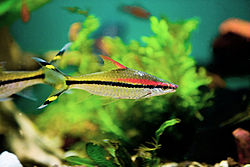Denison's Barb
| Denison's Barb (Puntius denisonii | |
|---|---|
 | |
| Conservation status | |
| Scientific classification | |
| Kingdom: | Animalia |
| Phylum: | Chordata |
| Class: | Actinopterygii |
| Order: | Cypriniformes |
| Family: | Cyprinidae |
| Genus: | Puntius |
| Species: | P. denisonii |
| Binomial name | |
| Puntius denisonii (Day, 1865) | |
| Synonyms | |
| Barbus denisonii (Day, 1865) | |
The Puntius denisonii (Denison's barb, Red line torpedo barb, Roseline shark or Bleeding eye barb) colloquially and more popularly referred to as Miss Kerala is a Subtropical fish belonging to the Puntius (Barb) genus in the Cyprinidae (Minnow) family. It is endemic to the fast- flowing hill streams and rivers of the state of Kerala and South Karnataka in South India. They prefer a water temperature range of 15-25 degree Celsius and almost certainly live for over 8 years. [1]
Contents |
Physical Characteristics
The fish is characterized by a torpedo-shaped body with silver scales, a red line running from their snout, through the eye, back towards the middle of the body; and below the red line, a black line that runs the length of the fish to the tail. As they mature, a distinctive green/blue marking on top of the head develops. The fish attains a maximum length of 15 cm (6 in).
Habitat and Threats
Denison's Barb or Red line torpedo barb is endemic and exclusive to the Achenkovil and Chaliyar rivers. Specifically, they are found in four locations- Cheenkannipuzha (a major tributary of Velapattanam River), the Achankovil river, the Chaliyar river and near Mundakayam town.[2] The species has an estimated range of 8'805 sq. km. P. denisonii is a benthopelagic species that is gregarious and shoals are known to occur in rocky pools with thick vegetation along their banks. They thrive in a subtropical climate in water with a 6.8–7.8 pH, a water hardness of 5–25 dGH and a temperature range of 65–79 °F (18–26 °C).
As reported by Practical Fishkeeping in January 2009, new research by team of scientists from India suggests that the species is being over-exploited for the aquarium trade, potentially placing it at risk of extinction. [3] In spite of being listed as Endangered by local assessment reports [4] the fish had been promoted as an 'Export item' by several government agencies!
The fish was most likely collected and exported out of India in 1996. In 1997, it won the third prize at 'Aquarama 1997' (world exhibition on Ornamental fish) under the 'New Species Category'[5]. By 2007-08 it constituted about 60- 65% of the total live ornamental fish exported from India which was worth US$ 1.54 million. Though the Government of Kerala banned the fishing and export of the endangered barb, it is yet to be listed under the National Wlidlife Protection Act.
Giving a shot in the arm of the conservationist is the news that the International Union for Conservation of Nature (IUCN) has in 2010 put the fish on their Red list regarded as the most comphrensive inventory of the global conservation status of plant and animal species since 1963. The species has been assigned Vulnerable (VU) status because of several reasons including restricted extent of occurrence (less than 20,000 sq. km), decline in habitat quality and number of mature individuals.[6]
Name origins
The Denison's barb was originally described as Labeo denisonii by F. Day in 1865. It is also referred to as Barbus denisonii, Crossocheilus denisonii, and Barbus denisoni. Common Names are Red Line Torpedo Barb, Denison's Barb, Roseline Shark, Red Line Barb, and Red Comet Barb.
In the aquarium

This fish is a relatively new addition to the fish keeping hobby. The Denison's barb is a schooling fish that is usually kept in groups. They tend to be peaceful but some have been known to be slightly aggressive around food, especially if kept in less space than they require. They eat bloodworms, shrimp, meat, fish flake and some vegetation. A similar fish, Puntius chalakudiensis is sometimes confused with this fish, but it is a larger, less colourful and a more aggressive species.
Breeding
Over the years many efforts have been made to breed this rapidly depleting species in captivity with limited success. Recent (2009) success has come from the work carried out at the Fisheries College, Kerala by Dr.T.V Anna Mercy. Equally if not more important breeding efforts have been carried out by the Chester Zoo and two amateur fish-lovers from Chennai- Mr. Venkatesh and Murali (as reported by The Hindu in October 2008).[7] These efforts would pave the way for standardizing the process and would be a major boost to conservation and ornamental fish trade in India.
See also
References
- ^ Denison's Barb page at Chester Zoo [1]
- ^ Mathew, Dennis Marcus. ‘Miss Kerala’ gets a protective shield, The Hindu(Feb 01,2010) [2]
- ^ Practical Fishkeeping(Jan 11 2009), Kerala government bans fishing for Puntius denisonii [http://www.practicalfishkeeping.co.uk/content.php?sid=1905
- ^ Molur, S. and Walker, S., Report of the workshop on ‘Conservation Assessment and Management Plan for Fresh Water Fishes of India’, Zoo Outreach Organization and NBFGR, Lucknow, 1998,p. 156.
- ^ Raghavan, R. et al., Aquat. Conserv: Mar. Freshwater Res., 2009, 19, 67–74.
- ^ Puntius denisonii in the IUCN Red List for Threatened Species [3]
- ^ Mathew, Dennis Marcus. ‘Miss Kerala’ gets a protective shield, The Hindu(Feb 01,2010) [4]
- Clarke, Matt. "The Red lined torpedo, Puntius denisonii (with details on an imposter species P. chalakudiensis)". Practical Fishkeeping. http://www.practicalfishkeeping.co.uk/pfk/pages/show_article.php?article_id=137. Retrieved April 19 2004.
- Denison's Barb on FishBase.
External links
| Wikimedia Commons has media related to: Puntius denisonii |
- Puntius denisonii breeding - Photos of Puntius denisonii’s epic journey from egg to hatchling, from www.fishesninverts.com
- Photos at Fishbase
- Madan Subramanian at Bangalore, India
- Puntius denisonii fish profile and detailed photos on fishforums.com
Free Template Blogger collection template Hot Deals BERITA_wongANteng SEO theproperty-developer


0 comments:
Post a Comment